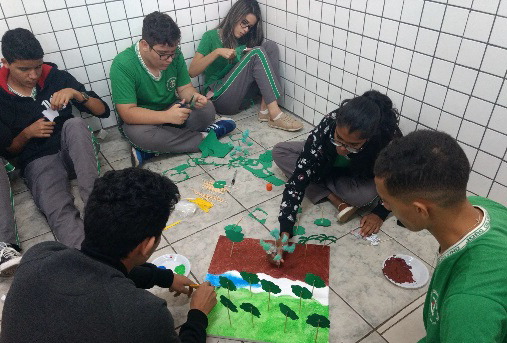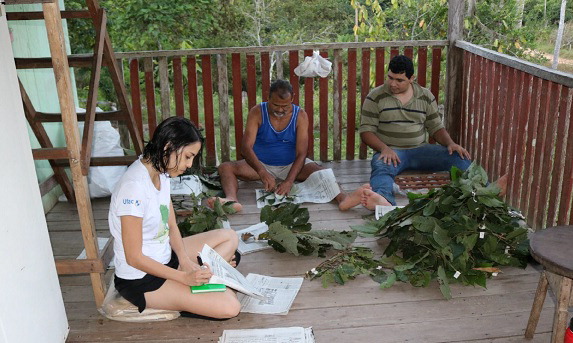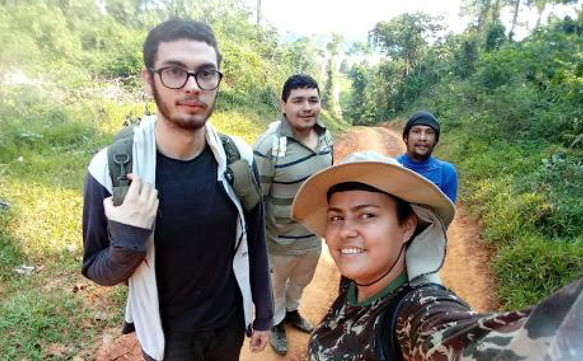Biodiversity in the Brazilian Amazon is the focus of numerous research initiatives, but significant knowledge gaps remain. The proposed project responds to several scientific priorities with regard to our understanding of forests in the Amazon. Forests in the southwestern Brazilian state of Acre are exceptionally biodiverse, but we still have limited information about many species. Further, climate change and extreme climatic events pose threats to forests, which require monitoring efforts that include fieldwork. The research team on this project will revisit established botanical plots to evaluate forest dynamics in terms of carbon stocks and biodiversity. This effort builds on previous work with National Science Foundation funding and under the RAINFOR program, both of which use established protocols. The team will also establish new botanical plots to fill coverage gaps in forest types underrepresented in existing plots. In both types of plots, they will add data collection protocols designed to detect changes in vegetation due to climate change, including tree mortality, seedling recruitment, and canopy gaps. These data collection protocols will permit more robust analyses in response to a suite of pressing scientific questions about forests in the Amazon. The revisits will allow analysis of forest dynamics, particularly by comparing carbon stocks and species composition over time. The new plots will expand forest coverage and plot sample size, providing a more representative picture of forests in Acre. Finally, the additional protocols will evaluate changes in forest structure and species composition in the context of debates over the implications of climate change for Amazonia.
The project team will share data with other researchers who also hold botanical data for Acre in order to expand their data sets. This will permit increased statistical power in hypothesis testing and open opportunities for additional collaborative publications. They will also deposit botanical specimens in regional herbaria, thereby increasing their importance as botanical collections and supporting taxonomic work in a region with many understudied species. Finally, their data dissemination plan seeks to take advantage of relationships among local communities by passing findings from their botanical plots to multiple communities and thereby expanding the reach of knowledge exchange. The planned capacity building efforts on the project highlight participatory methods to train community members in forest monitoring. This makes trainees capacity multipliers, since they can in turn implement the same participatory approaches to train other community members, thus increasing the project’s impact.
Final Summary of Project Activities
This PEER project had two main objectives: (1) to improve understanding of forest biodiversity and carbon stocks, and (2) to improve the capacity of stakeholders to use that knowledge for sustainable forest management. To meet the first objective, Dr. Sabina Ribeiro and her team remeasured six RAINFOR permanent plots located in the eastern portion of the state of Acre, Brazil. As most of these plots were established in the 1990s, they were able to evaluate how forest dynamics, species composition, and forest carbon were affected by the 2005 and 2010 Amazon droughts. They also studied the primary modes of tree mortality in these plots and the degree to which severe droughts increased the mortality rates of species with economic value. For that effort, two Master’s students from the graduate courses in Forest Science (Mr. Égon Castro) and Ecology and Natural Resources Management (Ms. Angélica Maciel) at UFAC were included in the PEER project. These studies resulted in three articles in proceedings: two for the
XXV IUFRO World Congress: Forest Research and Cooperation for Sustainable Development and one in the 2nd Rabeco (Reunião da Associação Brasileira de Ciência Ecológica e Conservação) and 6th SET (Simpósios de Ecologia Teórica). The team also produced a manuscript that was submitted to the journal
Forest Ecology and Management in late 2021, based on research done for Égon’s dissertation.
The researchers also established two new permanent plots in the CMER. Those plots serve to enhance the forest monitoring network in Acre, a state that is highly biodiverse and has different forest types but still lacks vegetation field data. These new plots (CUM-01 and SIB-01) were also incorporated in the
ForestPlots.net repository. Additional data collection protocols to assess the impacts of drought were included in the six remeasured plots. The team performed measurements on necromass (dead biomass), canopy openness, and natural regeneration to refine forest dynamics analyses and improve estimates of carbon stocks.
To disseminate the results of their work, the PEER team also presented several workshops about forest health. Some were part of the Conference
Viver Ciência: Educação e Saberes Amazônicos (Living Science: Education and Amazonian Knowledge. There, Dr. Foster Brown, Dr. Sabina Ribeiro, Dr. Fernando Schmidt and his graduate students, and Ms. Fiama Lima offered three workshops about forest health. The topics included discussions of how forest health may respond to climate change (FB, RS), the use of permanent plots to monitor forest health (SR, FL) and the use of ants as bioindicators of forest biodiversity and functioning (FS, graduate students). The audience for the conference included teachers and students ranging from elementary schools to university undergraduates. Dr. Sabina Ribeiro and two undergraduate students from UFAC also presented two workshops about forest health in the state public school “Escola Presbiteriana João Calvino”. Around 80 students, ranging from the 6th to the 12th grades, attended the workshop.
This PEER project also had a strong social component (second objective) that featured work with communities in the CMER to build their capacity to monitor their forests. Communities in the CMER have noted changes in their forests due to drought, and they face challenges in the monitoring and management of their forests. However, communities are also reconsidering forest culture and looking for other livelihood activities due to the fall of rubber prices and variations in the productivity of Brazil nut trees. As a result, forests in the CMER are being cleared, mostly for livestock. Communities in the CMER therefore prioritize partnerships that can bring them economic benefits. This carries the key implication that projects focusing on conservation goals are increasingly resisted by CMER communities. To address these issues, Dr. Ribeiro and her group sought to reconcile conservation and development via forest monitoring, an essential step in payments for ecosystem service (PES) programs that focus on carbon sequestration. They therefore designed a capacity-building program to implement a forest health monitoring program with CMER communities. Their approach was to train people in the use of technologies that involve skills not only necessary to participate in monitoring forest health, but which are also valuable in the job market. Hence, while their focus was on supporting a forest monitoring program, the training had applications to information management, a valued skill set in urban labor markets. At the same time, training in forest monitoring helped participants in rural communities to identify the linkages between forest health and local livelihoods and global climate. This allowed participants to quantitatively relate carbon stored in biomass to potential incomes from PES as a component of local livelihoods. The team faced several challenges in working with communities in the CMER, which can be summarized in three categories: (1) understanding community political cultures and practices; (2)organizing logistics to access communities in the CMER; and (3) managing expectations of community members about benefits. These challenges, as well as the adaptive strategies they adopted and their outcomes, are discussed in detail in a paper they published in the journal Ecology and Society (
https://doi.org/10.5751/ES-11665-250305).
Although the project ended as of January 31, 2021, Dr. Ribeiro will continue her research with the two permanent plots established under the PEER project, and she plans to establish more plots in the state of Acre. She wants to continue working with forest carbon stock, forest dynamics, and scientific knowledge dissemination to traditional communities. She also wants to further study the sustainability of forest management in the Brazilian Amazon. Dr. Ribeiro plans to continue to establish international partnerships to foster science development and human resources training in the state of Acre and in the MAP region (Madre de Dios-Acre-Pando). Dr. Ribeiro plans to continue studying forest dynamics in mature and secondary forests in the state of Acre, with emphasis on carbon stock and tree mortality. Currently, she is part of the project titled PROcess-based management of DIversity Generates sustainabilitY - PRODIGY, leaded by German universities, in which she participates in a sub-project leaded by Dr. Galia Selaya. They plan to study woody plant species traits and ant assemblies in the southwestern Amazonia as bioindicators of forest health and tipping points.
Evidence to Action SupplementIn 2018, Dr. Ribeiro was awarded a PEER Evidence-to-Action (EtoA) Supplement to broaden capacity building activities on her project by including students from rural areas and by expanding the geographic scope of our educational activities beyond the CMER. They incorporated the project “Forest Health” as a complementary activity in the Asas da Florestania or “Wings of Forest Citizenship” program of the Government of the State of Acre. This project allowed children and teenagers to better understand environmental issues in terms of forest health and to learn skills required for forest monitoring and sustainable forest management (SFM). That in turn can foster the development of positive attitudes towards the forest while inculcating skills necessary for SFM, now and in the future. To achieve this goal, the team created a learning kit containing materials and a book with dynamics for different knowledge areas to be used by students from the 6th to the 12th grades. The book (ISBN 978-85-60775-06-4) served as a guide for teachers on how to implement the dynamics inside classrooms to facilitate collaborative learning. Learning kits on Forest Health were disseminated in 10 municipalities in Acre (45% of all municipalities), encompassing the five regional divisions of the state of Acre (upper Acre, lower Acre, Juruá, Purus, and Tarauacá-Envira). In order to facilitate the implementation of the project in rural schools, the PI and her colleagues trained teachers, supervisors, and pedagogical coordinators in these municipalities on how to apply the kits in the classroom. They initially trained 49 teachers, supervisors, and pedagogical coordinators from the various municipalities in a one-day workshop in 2018. Due to political changes in the Government of Acre, they had to offer the training again to 68 participants in 2019. This time the trainings occurred in different locations and times. In total, 338 students from 20 rural schools located in 10 municipalities in Acre (two per municipality) participated in the Forest Health project. Of this total, 220 students were in middle school and 118 were in high school. A manuscript focusing on the activities developed under the project was in preparation as of late 2021.
Data and PublicationsThe dataset from the permanent plots the team remeasured and the two new permanent plots established in the CMER are available at the
ForestPlots.net repository, which aggregates information from permanent plots in tropical regions and provides cooperation and collaboration through data sharing for studies of vegetation dynamics in tropical regions.
During the PEER project period (2015-2021), Dr. Ribeiro and her colleagues produced six research products (number 3 and 5-9 below) that were directly linked with their PEER project activities and three (numbers 1, 2, 4) to which the project contributed data and/or comments on the manuscript.
1. DRAPER, F.C.; COSTA, F.R.C.; ARELLANO, G. et al. 2021. Amazon tree dominance across forest strata. Nature Ecology and Evolution 5: 757–767.
https://doi.org/10.1038/s41559-021-01418-y 2. FORESTPLOTS.NET; BLUNDO, C.; CARILLA J. et al. 2021. Taking the pulse of Earth's tropical forests using networks of highly distributed plots.
Biological Conservation 260: 108849.
https://doi.org/10.1016/j.biocon.2020.1088493. RIBEIRO, S. C.; SELAYA, N. G.; PERZ, S. G.; BROWN, F.; SCHMIDT, F. A.; SILVA, R. C.; LIMA, F. 2020. Aligning conservation and development goals with rural community priorities: capacity building for forest health monitoring in an extractive reserve in Brazil.
Ecology and Society 25(3):5.
https://doi.org/10.5751/ES-11665-250305 4. SULLIVAN, M. J. P.; LEWIS, S. L.; AFFUM-BAFFOE, K. C. et al. 2020. Long-term thermal sensitivity of Earth’s tropical forests.
Science 368(6493): 869-874.
https://doi.org/10.1126/science.aaw7578
5. MARQUES, E. L.; RIBEIRO, S. C.; LIMA, F. R.; SCHMIDT, F. A.; SILVA, R. C.; BROWN, I. F.; SELAYA, N. G.; PERZ, S. G. 2018.
Livro de dinâmicas: Projeto Saúde das Florestas. 1. ed. Rio Branco, AC: Associação SOS Amazônia. v. 1. 64p. ISBN 978-85- 60775-06-4
6. RIBEIRO, S. C.; SCHMIDT, F. A.; BROWN, I. F.; SELAYA, N. G.; PERZ, S. G.; SILVA, R. C. Projeto saúde das florestas: capacitação participativa para o monitoramento florestal comunitário. In: XXV IUFRO World Congress: Forest Research and Cooperation for Sustainable Development, 2019, Curitiba. XXV IUFRO World Congress: Forest Research and Cooperation for Sustainable Development. Pesquisa Florestal Brasileira 39: 260-260.
https://doi.org/10.4336/2019.pfb.39e201902043 7. LIMA, E. F. C.; RIBEIRO, S. C.; SANTOS, A. M.; SILVA, R. C. Biomassa lenhosa em floresta com bambu no Sudoeste da Amazônia. In: XXV IUFRO World Congress: Forest Research and Cooperation for Sustainable Development, 2019, Curitiba. XXV IUFRO World Congress: Forest Research and Cooperation for Sustainable Development. Pesquisa Florestal Brasileira 39: 261-261.
https://doi.org/10.4336/2019.pfb.39e201902043
8. SILVA, R. C.; RIBEIRO, S. C.; SANTOS, A. M.; LIMA, E. F. C. Possíveis impactos na estrutura da vegetação frente aos eventos de secas severas no Sudoeste da Amazônia. In: XXV IUFRO World Congress: Forest Research and Cooperation for Sustainable Development, 2019, Curitiba. XXV IUFRO World Congress: Forest Research and Cooperation for Sustainable Development. Pesquisa Florestal Brasileira 39: 262-262.
https://doi.org/10.4336/2019.pfb.39e2019020439. SANTOS, A. M.; LIMA, E. F. C.; SILVA, R. C.; RIBEIRO, S. C. Severe droughts increase mortality rates of forest species with economic value in southwestern Amazon? In: 2ª Rabeco (Reunião da Associação Brasileira de Ciência Ecológica e Conservação) e 6º SET (Simpósios de Ecologia Teórica), 2018, Campinas, SP. 2ª Rabeco (Reunião da Associação Brasileira de Ciência Ecológica e Conservação) e 6º SET (Simpósios de Ecologia Teórica), 2018.






